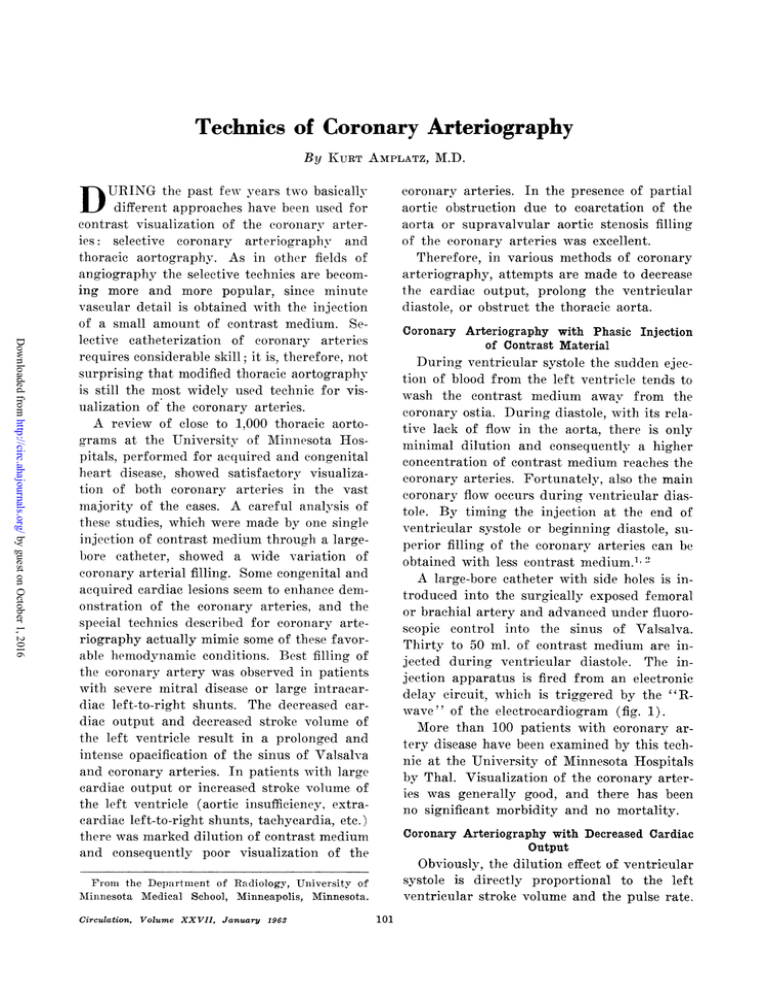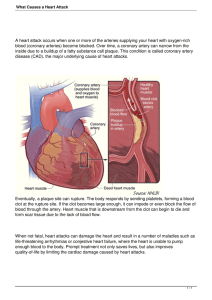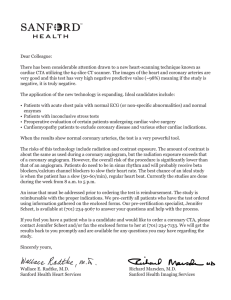
Technics of Coronary Arteriography
By KURT AMPLATZ, M.D.
Downloaded from http://circ.ahajournals.org/ by guest on October 1, 2016
D URING the past fewv years two basically
different approaches have been used for
contrast visualization of the cor-onary arteries: selective coronarv arteriographv and
thoracic aortography. As in other fields of
angiography the selective technics are becoming more and more popular, since minute
vascular detail is obtained with the injection
of a small amount of contrast medium. Selective catheterization of coronary arteries
requires considerable skill; it is, therefore, not
surprising that modified thoracic aortography
is still the most widely used technic for visualization of the coronary arteries.
A review of close to 1,000 thoracic aortograms at the University of Minnesota Hospitals, performed for acquired and congenital
heart disease, showed satisfactory visualization of both coronary arteries in the vast
majority of the cases. A careful analysis of
these studies, which were made by one single
injection of contrast medium through a largelore catheter, showed a wide variation of
coronary arterial filling. Some congenital and
acquired cardiac lesions seem to enhance demonstration of the coronary arteries, and the
special technics described for coronary arteriography actually mimic some of these favorable hemodynamic conditions. Best filling of
the coronary artery was observed in patients
with severe mitral disease or large intracardiae left-to-right shunts. The decreased cardiae output and decreased stroke volume of
the left ventricle result in a prolonged and
intense opacification of the sinus of Valsalva
and coronary arteries. In patients with large
cardiac output or increased stroke volume of
the left ventricle (aortic insufficiency, extracardiac left-to-right shunts, tachyeardia, etc.)
there was marked dilution of contrast medium
and consequently poor visualization of the
coroniary arteries. In the presence of partial
aortic obstruction due to coaretation of the
aorta or supravalvular aortic stenosis filling
of the coronary arteries was excellent.
Therefore, in various methods of coronary
arteriography, attempts are made to decrease
the cardiac output, prolong the ventricular
diastole, or obstruct the thoracic aorta.
Coronary Arteriography with Phasic Injection
of Contrast Material
Duringf ventricular systole the sudden ejection of blood from the left ventricle tends to
wash the contrast medium awav from the
coronary ostia. During diastole, with its relative lack of flow in the aorta, there is only
minimal dilution and consequently a higher
concentration of contrast medium reaches the
coronary arteries. Fortunately, also the main
coronary flow occurs during ventricular diastole. By timing the injection at the end of
ventricular systole or beginning diastole, superior filling of the coronary arteries can be
obtained with less contrast medium.',
A large-bore catheter with side holes is introduced into the surgically exposed femoral
or brachial artery and advanced under fluoroscopic control into the sinus of Valsalva.
Thirty to 50 ml. of contrast medium are injected during ventricular diastole. The injection apparatus is fired from an electronic
delay circuit, which is triggered by the "Rwave" of the electrocardiogram (fig. 1).
More than 100 patients with coronary artery disease have been examined by this technic at the University of Minnesota Hospitals
by Thal. Visualization of the coronary arteries was generally good, and there has been
no significant morbidity and no mortality.
Coronary Arteriography with Decreased Cardiac
Output
Obviously, the dilution effect of ventricular
systole is directly proportional to the left
ventricular stroke volume and the pulse rate.
FrIoi-i the Departnlent of Radiology, Uiniversity of
Minnesota Medical School, Minneapolis, Minnesota.
Circulation, Volume XXVII, January 196
6
101
AMIIPLATZ
1029
Downloaded from http://circ.ahajournals.org/ by guest on October 1, 2016
Figure 2
C(o n,arr
Figure 1
Coronary arteriogram performed by phasic (lye
injection. Occlusion of anterior descending, severely diseased right coronary artery and collateatl
circulation from the left circumflex are lell dem-
p erfor nmed.-S cu r in.fi tiln
Valsa lva maneai'cr show's diffused athieromatoa.
changes and. marked niarroicing of the left ante-ior
descending branch. Note inadequate risualizatiot'll
of thke left main coronary a rter?l d,In toa supermpa.stion11 of opacifie ci aorta.
arter l,,rp an
;nstrated.
By artificial reduction of the cardiac output
this dilutioil can be minimized and the contrast visualization of the coronary arteries can
be significantly improved. A simple and effective technic of decreasing cardiac output is
the Valsalva maneuver. By, havingu the patienit
exhale forcefully against the closed glottis.
cardiac output is decreased by approximately
40 per cent, allowing prolonged and denser
opaeification of the aseending aorta.3 A largebore Polyethylene or Teflon catheter is introdueed percutaneouslv into the femoral or
sulelavian artery, and 40 to .50 ml. of contrast
medium are delivered with a power injector
(fig. 2). During general anesthesia cardiac
output is sinmply reduced by elevatingo the
intrabronehial pressure to 40 em. of water.
Coronary Arteriography during Cardiac Arrest
and Its Modifications
Arnulf5 made an important accidental diseoverv. While cloing' aortograms in animals,
he obtained an outstandinlg coronary arteriogram in a dog in whieh accidental. cardiac
arrest ocecurred just prior to the injection.
He used this knowledge to describe a new way
of corollary arteriography- durinlg cardiac arrest incdueed by the injection of acetyleholinie
(fig. 3). Aectyleholinie is an- apparentlv harmless drug, whiclh is rapidly d estroyed in thc
lhumani body; it has also beeni uised by psyehiatrists for shock treatment. Arnuilf advocates
the initravenous injection of a large amouilt
(3 mng. per klilo body weight . resulting ini
cardiac arrest of several seconds' durationi.
e-o
As soon as asvstole has occurred. as seen
the electroeardiograim. 20 nil. of conitrast mediiin are injeected via cathleter or nieedle into
the ascending, aorta. In spite of an apparently
wvide margini of safety a proloniged cardiac
arrest may persist requiring the inijection of
atropine through the eatheter as an antidote.
According to Arnulf6 this wa- niecessary in
only I of 24 examined patieitts. Since the
Circulation, Volume XXVII. January t,'i
103
SYMPOSIUM ON CORONARY ARTERIOGRAPHY
Figure 4
Downloaded from http://circ.ahajournals.org/ by guest on October 1, 2016
rigure 3
Coronary system in normal dog is well demonstrated by aortogram performed during acetylcholine arrest.
A. Patient with coronary artery disease examinedI
by phasic dye injection: very poor demonstration
of the left coronary artery. B. (Same patient.)
Re-examination performed during acetylcholine
arrest shows well a diffusely diseased left coronary
artery, which is, however, patent. A pacemaker
electrode (carrow) has been introduced into the
right ventricle ria the saphenous vein in order to
restart the heart.
publication of this classic work, the basic
technic has been modified in several ways:
1. Acetylcholine can be injected directly
through the catheter into the sinus of Valsalva. By doing so, much smaller amounts are
required and cardiac arrest occurs almost immediately following the injection.7
2. After acetylcholine asystole has been induced, atropine may be injected together with
the contrast medium to terminate the cardiac
arrest.
3. An external or internal pacemaker may
be used to disrupt the pharmacologically induced cardiac arrest at will8 (fig. 4).
Occlusion Aortography
A Dotter-balloon catheter is introduced into
the surgically exposed brachial artery and
advanced into the ascending aorta. It is inflated with carbon dioxide, and contrast medium is injected proximally to the occluded
aorta. The injection is made during acetylcholine-induced cardiac arrest.9
Semi-selective Technic
Selective and semi-selective technics have
replaced some of the above-mentioned methods of coronary arteriography that require
Circulation, Volume XXVII, January 1968
Figure 5
Normal right coronary artery well demonstrated
by injection of the right cusp. Note preferential
filling and poor visualization of left coronary
a rtery.
complex equipment. By delivering the opaque
substance close to the origin of or directly
into the coronary arteries, superior visualization can be obtained with a smaller amount
of contrast medium. A simple semi-selective
technic is placement of the catheter tip into
the right or left coronary sinus. By doing so
14AIPPLA TZ
104
Downloaded from http://circ.ahajournals.org/ by guest on October 1, 2016
Figure 7
Landmuarks pS
flo reuta:nc(Jeous ,ubclavi-i cirteriq
catheteriz.ation. Dotted Min( inldicates direction. o
needle.
Figure 6
Atheromatous plaques in right coronarqf moterj
well visualized )/ lao]) catheter and Volsali n
maneuver.
there is preferential filling of the cororary
artery arisingo from the injected sinus (fig. 5a
This technie is reliable and relatively simple,
especially if the catheter is introduieed
through the brachial or subelavian arterv
rather than through the feinoral.
Williams10 described the loop catheter whiclh
allows semi-selective opaeificatioii of both
coronary arteries with one single injectiol.
The catheter ring is positioned just above the
sinus of Valsalva, and the jet of contrast me(liuni is directed downward and laterally
through numnerous lateral side lholes. The
catheter can be introduced percutaneously.
anid usually manual injectioni is adequate.
with positioning of the catheter properly just,
above the coronary ostia. If the contrast medium is delivered with a power iinjector, the
side holes in the catheter loop have to be arranged differently in order to prevent displacement by recoil. Good opacification- of the
Figure 8
-V. Catheter needle vs(d
1'o1' 5sidela nl O1't(? (oat/'
eteriz,oCltionQ. B). Curvl-led flexIle guie
fonr0 p;osS,incf
Teflon tubing b)eyIond vertebral rtrterY
coronary arteries can be obtained by this sim:lple teelnic, especially by combininig this procedure with the Valsalva maneuver (fig. 6
Selective Coronary Arteriography by Percutaneous Arterial Catheterization
By far the best demoonstrationi of aiiatomic
detail is obtain-ed by selective inljectionI of the
coronary arteries. By insertin(g the catheter
into the surgically exposed rioht braehial
artery Sones"1 has applied this technie in a
large group of patients. More and more
angiographie procedures and e-ven coronary
arteriography are earried out hy radiolooists
wvlho prefer to initroduce the catheter pereutaneously rather than by surgical arteriotoimiv
If the catheter is introduced percutaneouslv
into the femoral arter-, the left coroiiarv
artery can be entered with fair conisistencyv.
Circulation, Volume XXVIl,
January 1963
105
SYMPOSIUM ON CORONARY ARTERIOGRAPHY
Downloaded from http://circ.ahajournals.org/ by guest on October 1, 2016
but catheterization of the right coronary
artery is extremely difficult. Percutaneous
catheterization of the brachial artery is usually not satisfactory because of the rather
commonly present arterial spasmi and consequently decreased maneuverability of the
fairly long catheter. The development of ani
infraclavicular subelavian artery catheterization technic12 proved practical for this procedure, since the subelavian arterv is a large
vessel that does not go into arterial spasm,
allowing good control over a very short catheter.
Catheterization techniies and landmarks are
as follows:
A horizontal line is draw-mi perpendicularlythrough the mnidsternal line approximately
olle finger below the jugular iioteh (fig. 7.
The skin is infiltrated with a local anesthetic
at this level approximately one finger laterally to the midelavicular line. A small "nick'
through the skin is made with a no.-11 knife
blade, and a 6-inch, wide-lumen, no.-18 thinwalled needle with a snugly fitting Teflon
rider is used for arterial puncture (fig. 8A).
The catheter needle is directed obliquely upward and medially toward the subelaviarn
artery, whieh is palpated with the index finger of the other hand in the supraclavicular
fossa. The subela-vian artery is usually easily
palpable at a point where it crosses the first
rib. The upward direction of the needle and
the fact that the subelavian artery is punctured over or preferably laterally to the first
rib minimize the occurrence of pneumothorax.
The pulsating artery is localized with the
needle tip and punctured with a short, jabbing motion. As soon as free arterial blood
flow is obtained the needle is removed, and
the catheter is advanced intra-arterially. Almost invariably the catheter enters the mouth
of the vertebral artery, which is a desirable
feature if vertebral angiography is contemplated. In order to pass the Teflon catheter
into the innominate artery a soft,- sharply
curved, spring stylet is gently introduced as
a guide (fig. 8B). The Teflon tubing is now
replaced by a curved radiopaque polyethylene
catheter by Seldinger's technic. 13 The coronary arteries are catheterized according to
Circulation, Volume XXVII, January 1963
Figure 9
Selective coronary arteriogrant. Sintgle spot film
obtained at the end of injection.
Sonies and injected manually with contrast
medium. In our experience a single radiograph made at the end of the injection by
means of the spotfilm device or overhead tube
proved adequate14 (fig. 9). Following the procedure the catheter is withdrawn and the subclavian artery is compressed against the first
rib in the supraclavicular fossa for approximately 10 minutes. Adequate compression is
indicated by disappearance of the radial pulse.
Because of the easy compressibility of the subclavian artery against the first rib, hematomata have been very rare in our experience,
which is still limited to approximately 100
catheterizations.
Discussion
Coronary arteriography in patients with
coronary artery disease and consequently impaired coronary flow is one of the most difficult angiographic procedures. Simple thoracic
aortography is considered very adequate for
visualization of normal coronary arteries, but
in the presence of occlusive coronary artery
disease contrast filling is commonly unsatisfactory. The term "coronary arteriography"
as a special procedure and the described spe-
AMPLATZ
106
Downloaded from http://circ.ahajournals.org/ by guest on October 1, 2016
cial technies are, therefore, justified and indicated for visualization of the diseased
coronary artery system.
Thoracic aortography with its modifications
allows visualization of both coronarv arteries
with one single injection. The commonly used.
rapid biplane radiography is very useful,
since atheromatous plaques may be overlooked
unless thev are seen in profile in the anteroposterior or lateral projection.
One of the major drawbacks of modified
thoracic aortoffraphy is superimiposition of the
opacified aorta upon the first portion of the
coronary arteries. True profile views of the
origin of right or left coronary arteries can
be obtained only if proper oblique projectionis
are inade. Obviously, adequate visualizationi
of the mouth of the coronary arteries is of
o reat
practical significance. sinee localizecl
atheromatous disease in this location is amenable to surgery. Somnetimes, due to rotationi
of the heart, almost the entire left muain coronary artery may be obscured bv the opacified aorta in the anteroposterior projectioni
(fig. 2). Because of this major drawbaek of
thoracic aortography, it is not surprisiing that
the selective injection teehliic has becomie
mnore popular in recenit vears. Tt is simple
and pro-vides the best anatomic and hemod-niamic informationi without the use of complex, cumbersomne electronie equipmnent. The
origin of the injected coroniary artery cani
usually be well seen by regurgitation of con1trast medium into the sinus of Valsalva. The
hlemodynamic alterationi of coroniarv artery
disease anid especiallv the collateral eirculation- cani best be effectively studied bv selective inljection combined+lwith cineradiocraphy.
By eliminating the (utdown on the brachial
arterv and introducing the catheter pereutaneously inito the subelaviaii or axillary arterv.
the techniie can be further simplified and mnade
available to radiologists.
Summary and Conclusions
proposed procedures, inadequate visualization
of the origin of the coronary arteries, and
inconsistent results have paved the way for
the selective catheterization teehnlie, which appears to be the procedure of choice in the
band of experts.
References
1. RICHARDS, L. S., AND THAL, A. P.: Phasic dye
2.
3.
4.
.5.
ii.
S.
9.
101.
1 1.
12.
13.
VTarious methods of coronary arteriography
have been briefly reviewed. Most of these
technics represent modificatiolns of thoracic
aortography. The conmplexity of some of the
14.
injection control system for coronary arteriography in the human. Surg. Gynec. & Obst.
107: 739, 1958.
THAL, A. P.: The clinical usage of coronary
arteriography. Angiology 11: 238, 1960.
CROWLEY, W. P. JR., GRACE, J. 13., FOX, 1. J..
AND WOOD, E. H.: Effect of Valsalva maneuver
on thoracic-aortic blood flow in man. Am. J.
Physiol. 187: 594, 1956.
NORDENSTROM, B., OVENFORS, C. Q., AND T6RNELL.
G. Coronary angiography iII 100 cases of
isehemic heart disease. Radiology 78: 714.
1962.
ARNULr, G., AND BUFFARD, P.: Die Arteriog-aphie der Koronarien Mittels Azetyleholin.
Fortschr. Geb. Roentgenstrahlen 92: 115, 1960.
ARNULY, G.: Bases et technique de l'arteriographie. MIethodique de coronaires. AMeni. Acad.
Chir. 86: 387, 1960.
GENSINT, G. G., DIGIORGI, S., AND BLACK, A.:
New approaches to coronary arteriography.
Angiology 12: 2293, 1961.
RBILGUTAY, A. MI., AND LILLEHEI, C. W.: A new
nethod for coronary arteriographv. .J.A.M.A.
In press.
DOTTER, C. T., FRISCHE, L. H., IOSKINSON, W. S.,
KAWASTIPIA, E., AiND PHILLPS, R. W.: Coronary arteriography, during induced cardiac
arrest and aortic occlusion. Arch. hnt. Med.
104: 720, 1959.
WILLIAMS, J., LA4EIATERT, P. B., BELLMIAN, S.,
FRANK, H., ANTD LITTMAN, D.: Peripheral opaciflcation of the aortic stream. A method for
selective x-ray demonstration of the coronary
arteries and other visceral branches of the
aiortai. Surgical Forum 10: 649, 1959.
SONES, F. M., JR., SHIREY, E. K., PROUDFIT,
W. L., AND WESTCOTT, R. N.: Cine-coronary
arteriography. Abstract, Circulation 20: 773,
1959.
APrLArTZ, K., AN_D HARNER, R.: A\ neW subelavian
artery catheterization technique. Radiology. hii
press.
SELDINGER, S. 1.: Catheter replacemnent of the
ineedle in percutaneous arteriography. A new
technique. Acta Radiol. 39: 368, 1953.
AMPLATZ, K.: Selective corollary arteriography
by percutaneous arterial catheterization. In
press.
Circulation, Volume XXVII, January 196S
Technics of Coronary Arteriography
KURT AMPLATZ
Downloaded from http://circ.ahajournals.org/ by guest on October 1, 2016
Circulation. 1963;27:101-106
doi: 10.1161/01.CIR.27.1.101
Circulation is published by the American Heart Association, 7272 Greenville Avenue, Dallas, TX 75231
Copyright © 1963 American Heart Association, Inc. All rights reserved.
Print ISSN: 0009-7322. Online ISSN: 1524-4539
The online version of this article, along with updated information and services, is
located on the World Wide Web at:
http://circ.ahajournals.org/content/27/1/101.citation
Permissions: Requests for permissions to reproduce figures, tables, or portions of articles
originally published in Circulation can be obtained via RightsLink, a service of the Copyright
Clearance Center, not the Editorial Office. Once the online version of the published article for
which permission is being requested is located, click Request Permissions in the middle column of
the Web page under Services. Further information about this process is available in the Permissions
and Rights Question and Answer document.
Reprints: Information about reprints can be found online at:
http://www.lww.com/reprints
Subscriptions: Information about subscribing to Circulation is online at:
http://circ.ahajournals.org//subscriptions/








